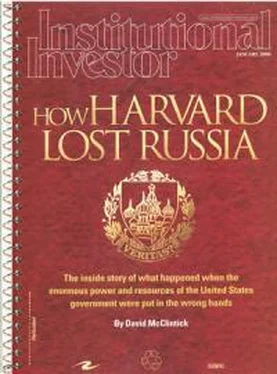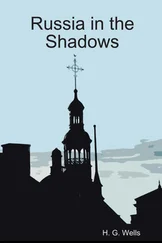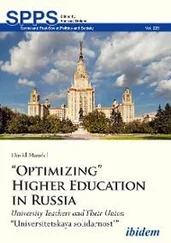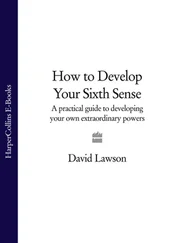Left to be privatized at the end of 1991 were approximately 225,000 state companies spread across Russia. Gaidar and Chubais, advised by Shleifer, decided that these enterprises could not be privatized one at a time. That would take "well into the 22nd century," Gaidar figured. Rather, they had to devise a form of the shock therapy that had been used in Poland -- near-simultaneous privatization.
So in 1992 the Russian government began issuing certificates with a face value of 10,000 rubles each to all of the 148 million citizens of the country. The certificates were liquid; they could be traded or used to purchase property. By the end of 1992, 46,000 small enterprises out of the 225,000 were in private hands. Chubais, Vasiliev and Shleifer had privatization off to a good start, and Shleifer was forging strong personal relationships with his Russian advisees.
While helping draft securities laws, Richard Bernard, who moved to Moscow in 1992, fired off letters to thenU.S. secretary of State Lawrence Eagleburger urging that the U.S. government support one of the pivotal movements of history -- the transformation of the Russian economy from communism to capitalism. Though Bernard never heard from Eagleburger, there was action in Washington.
In October 1992, just a few weeks before losing the presidency to Bill Clinton, president George H.W. Bush signed the Freedom for Russia and the Emerging Eurasian Democracies and Open-Market Support Act. It authorized up to $350 million in aid to Russia, to be provided and managed by AID, which already had an advance team working informally in Russia at the government's invitation.
In short order, AID, learning that Sachs and Shleifer were in Moscow, contracted with Harvard to direct and manage the reform program. The agency initially gave $2.1 million to Harvard, which would run the operation out of its Harvard Institute for International Development, a 30-year-old entity located on Eliot Street in Cambridge. With financial support from foundations, international aid agencies, development banks and host governments, HIID operated economic reform programs around the world, concentrating on assisting nations that were changing from government-run to market-driven economic systems. In Indonesia, for example, HIID helped revise the tax system and liberalize financial markets. It also had been active in Colombia, Kenya, Pakistan and Zambia.
The Russia Project would be HIID's largest and most important program by far. The institute had been run since 1980 by Harvard political economy professor Dwight Perkins, who reported directly to Albert Carnesale, Harvard's provost and second-in-command. With Sachs advising Gaidar, the HIID project would be directed by Shleifer, who would retain his professorship in the economics department. Shleifer was charged with hiring staff, setting budgets and priorities and creating and supervising the project from Cambridge and on frequent trips to Russia.
Shleifer's first need was to find someone who could supervise the day-to-day operations of the Russia Project. For this critical post he chose Jonathan Hay, 30, an Idaho native, Rhodes Scholar and newly minted graduate of Harvard Law School.
Fluent in Russian, Hay had moved to Moscow hoping to get in on the excitement of social transformation. Brilliant and intense, with unruly hair, oversize horn-rim glasses and an ethereal academic mien, he dazzled everyone he encountered. Hay had negligible practical experience, but soon, with Shleifer's blessing, he was setting up Harvard's Moscow operations at Chubais's GKI in a drafty government building near Red Square. "We had no heat, no Xerox, no fax, no food," Hay recalled later to the Washington Post 's David Hoffman, author of The Oligarchs: Wealth and Power in the New Russia . "The first time I came there, I saw just Dmitri Vasiliev and 30 people sitting in a huge hall, just this small man in big glasses, and they were all around him, in a heated discussion, talking about small-scale privatization."
AID gave the Harvard people wide independence and discretion. HIID relied heavily on Shleifer and Hay, who savored the challenge. The young lawyer had a high tolerance for chaos, which came in handy at the end of 1992. "Don't worry! Be happy!" is the way lawyer Barenboim characterized Hay's approach to reforming Russia.
The country's banking system was barely functional. ATMs were unheard of. There were a few rudimentary stock exchanges spread across the nation, but trading was chaotic. Few laws, regulations or formal procedures had yet taken effect.
Meanwhile, much of the Russian Parliament believed Yeltsin was moving too fast, too soon. The fall of 1993 was marked by turmoil as the president and his opponents struggled for supremacy. When Yeltsin's rivals in Parliament refused to leave the legislative building known as the White House, the president cut off its television service, telephones, electricity and water. Tanks rolled, bullets flew, scores of people died -- and Yeltsin prevailed, with more freedom to proceed with economic reform.
A mile from the Kremlin, however, the people in charge of the Russia Project were becoming seriously distracted. Under their contract with the U.S. government, Shleifer, Hay and their staff were required to submit regular written progress reports, but they were falling behind. "We have reviewed the delinquent . . . reports and found them to be sorely lacking in substance," an AID staffer in Moscow informed Washington.
One reason for Shleifer and Hay's distraction may have been a growing interest in their own opportunities. As advisers on fundamental reform of the Russian economy, HIID staffers were privy to the most-private details of the vast nation's financial future. They were swimming in inside information. They were hemmed in, however, by strict prohibitions against using their positions for personal financial gain. The U.S. government and Harvard -- as well as the contract that Harvard and AID signed in December 1992 -- barred everyone assigned to the project, their families and people acting on their behalf from any investment of their personal funds in Russia and any personal involvement in Russian businesses or financial transactions. Even savings accounts in Russian banks were prohibited.
"We had this test -- how is this going to look on the front page of the New York Times ?" Louisa French, HIID's human resources officer, said under oath in the government's lawsuit. "It was our mantra to say, 'If you have to ask, you're too close to the line.'"
As the people running the project, Shleifer and Hay were obliged not only to obey the rules themselves but also to enforce them on their staffs. But by December 1993, less than a year after the Russia Project had ramped up, Alberto Neri, a Moscow-based HIID financial officer, wrote four memorandums warning the institute's deputy director in Cambridge, Rosanne Kumins, that he believed Harvard was complicit in financial irregularities and tax evasion and was condoning dissemination of false data, irregularities in employment contracts and misrepresentation of expenditures, all so that income to the Russian staff could be hidden from the tax authorities.
"I fail to see why Harvard should assume the huge responsibility of abetting tax evasion (which is a criminal offense in Russia -- as it is in the USA . . .)," Neri wrote in one memo. The memos were entered into evidence and cited by the U.S. government in court papers in its lawsuit.
Those memos, Kumins says today, "were received with concern. We never condoned tax evasion. As a result, we changed the way local hires were paid."
In July 1994, Shleifer and Nancy Zimmerman began investing in Russia in direct violation of his contract and the restrictions imposed by AID and Harvard.
Though she called her husband "Boss," Zimmerman, 31, was a hard-charging financial wizard in her own right. She had left a lucrative career at Goldman, Sachs & Co. in New York to start a hedge fund in Cambridge, Farallon Fixed Income Associates, in a joint venture with Farallon Capital Management, a prominent fund group based in San Francisco. Zimmerman earned far more trading bonds than Shleifer did teaching economics: $1.06 million to his $191,000 in 1994. Their combined income supported a comfortable lifestyle, including a spacious home in the affluent Boston suburb of Newton.
Читать дальше






![Джонатан Димблби - Barbarossa - How Hitler Lost the War [calibre]](/books/385421/dzhonatan-dimblbi-barbarossa-how-hitler-lost-the-w-thumb.webp)





